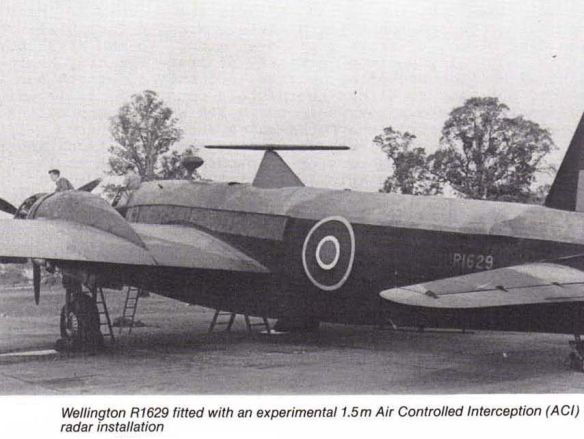
In late 1944 a radar-equipped Vickers Wellington bomber was modified for use by the RAF’s Fighter Interception Unit as an Airborne Early Warning and Control aircraft. Flying at an altitude of 4,000 feet (1,200 m) over the North Sea, it directed Mosquito fighters charged with intercepting He 111s from Dutch airbases that sought to launch V-1s from the air.
In June 1944, the home-based night fighter squadrons were suddenly pitched into a defensive battle against the first of Hitler’s `revenge weapons’ – the V-1 flying bomb. The Mosquitoes opened their score against the V-1s on the night of 15/16 June, when a Mosquito VI of No. 605 Squadron from Manston (Flight Lieutenant J. G. Musgrave and Flight Sergeant Sanewell) exploded one over the Channel. Four Mosquito squadrons – Nos 96, 219, 409 and 418 – were assigned exclusively to anti-flying bomb operations, known as Diver patrols, and were joined later in June by Nos 85, 157 and 456. Other squadrons operated against the V-1s on a part-time basis, as priority was given to patrolling the Normandy beachhead. Between them, the seven full-time anti-Diver Mosquito squadrons claimed 471 flying bombs, while the part-timers claimed 152 to give a combined total of 623, or about one-third of the RAF’s total claim against the V-1s.
The Mosquito squadrons began to take losses in the later phases of the campaign against the V-1. In September 1944, with their bases in the Pas de Calais overrun by the Allied advance, the enemy began flying bomb attacks on London and other UK targets, such as Portsmouth and Southampton, with V-1s air-launched from Heinkel He 111s of KG 53. Later in September air launches were made against east coast targets from positions off the Dutch coast. Catching the Heinkel launchers was very difficult, for they flew slowly at low level, and several Mosquitoes were lost to return fire, or because they stalled at low speed while trying to intercept. In an attempt to improve interception rates, a radar picket ship, the frigate HMS Caicos, and a specially equipped radar Wellington of the Fighter Interception Unit were used to direct the Mosquitoes, which patrolled over the sea at about 4,000 feet between Britain and Holland. These operations continued until 14 January 1945, by which time KG 53 had lost seventy-seven aircraft, forty-one of them on operations.
Although pulled back to airfields in Germany, KG 53 was not quite finished with the air launched missile programme. Firings continued throughout December and drew in another innovation as a counter to their attacks on Britain. Throughout 1941 and on into 1942 and 1943, the Telecommunications Research Establishment (TRE) had conducted a series of operational experiments using a Wellington bomber in the ‘Air Control of Interception’ (ACI) role, or what today would be called ‘Airborne Early Warning’ (AEW). First mooted in August 1941 by Watson Watt in his capacity as DCD, as a means of directing fighters onto the Focke Wulf Fw 200 Condor patrols in the North Atlantic, TRE had equipped Wellington Ic, R1629, with a rotating Yagi dipole array, an ASV Mk.II receiver, a special high powered transmitter and a nine inch (23cm) PPI display. Successfully trialled several times in 1942 and 1943, but dismantled in April 1943, R1629 was written off in a ground accident the following October. During January 1945 the Fighter Interception Development Squadron (FIDS), a part of the recently created Central Fighter Establishment (CFE) which was raised to supersede Fighter Interception Unit (FIU) in October 1944, undertook a series of trials at Ford and Manston in the ACI role under the codename Operation Vapour.
Using an ex-Coastal Command Wellington fitted with an ASV Mk.VI radar and PPI display, these trials were practised in the Channel during the hours of daylight in early January 1945 and flown operationally off the Dutch coast at very low level, in the company of five Mosquito night-fighters. Using the Rebecca/Eureka beacons system to maintain a formation, the set-up was controlled by a New Zealand civilian scientist, Mr E.J. Smith, from the Wellington, who provided vectors to likely targets for the accompanying Mosquitoes. Overall, the results proved disappointing since the sea returns restricted the ACI’s maximum range when flying at low level, but ranges of 14 miles (22.5 km) were recorded at higher altitudes – which were twice as good as the Mosquito’s AI Mk.X. However, at the critical point the Luftwaffe ceased air-launching operations on 14 January and the ACI project was allowed to fall into abeyance.